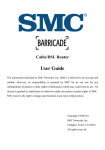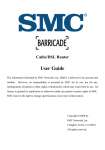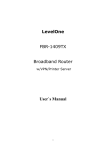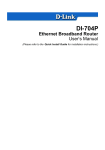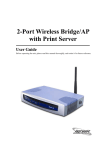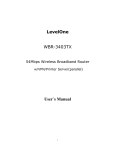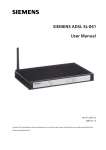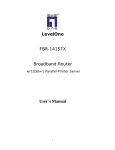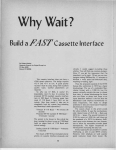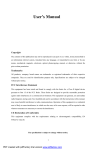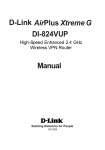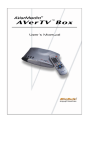Download LevelOne 22Mbps User's Manual
Transcript
LevelOne WBR-2401 22Mbps Wireless ADSL Firewall/VPN router w/Printer Server User`s Manual 1 FCC Interference Statement This equipment has been tested and found to comply with the limits for a Class B digital device pursuant to Part 15 of the FCC Rules. These limits are designed to provide reasonable protection against radio interference in a commercial environment. This equipment can generate, use and radiate radio frequency energy and, if not installed and used in accordance with the instructions in this manual, may cause harmful interference to radio communications. Operation of this equipment in a residential area is likely to cause interference, in which case the user, at his own expense, will be required to take whatever measures are necessary to correct the interference. CE Declaration of Conformity This equipment complies with the requirements relating to electromagnetic compatibility, EN 55022/A1 Class B, and EN 50082-1. This meets the essential protection requirements of the European Council Directive 89/336/EEC on the approximation of the laws of the member states relation to electromagnetic compatibility. 2 Table of Contents Chapter 1 Introduction...................................................................................................... 5 Functions and Features .............................................................................................. 5 Packing List ............................................................................................................... 7 Chapter 2 Hardware Installation....................................................................................... 7 2.1 Panel Layout ........................................................................................................ 7 2.2 Procedure for Hardware Installation .................................................................... 9 Chapter 3 Network Settings and Software Installation................................................... 11 3.1 Make Correct Network Settings of Your Computer ........................................... 11 3.2 Install the Software into Your Computers .......................................................... 12 Chapter 4 Configuring Wireless ADSL Broadband Router ............................................ 14 4.1 Start-up and Log in ............................................................................................ 14 4.2 Status.................................................................................................................. 15 4.3 Wizard................................................................................................................ 16 4.4 Basic Setting ...................................................................................................... 18 4.4.1 Primary Setup – WAN Type............................................................................ 19 4.4.2 DHCP Server................................................................................................... 33 4.4.3 Wireless Setting, and 802.1X setting .............................................................. 35 4.4.4 Change Password ............................................................................................ 37 4.5 Forwarding Rules............................................................................................... 38 4.5.1 Virtual Server .................................................................................................. 39 4.5.2 Special AP....................................................................................................... 40 4.5.3 Miscellaneous Items........................................................................................ 41 4.6 Security Settings ................................................................................................ 42 4.6.1 Packet Filter .................................................................................................... 43 4.6.2 Domain Filter .................................................................................................. 48 4.6.3 MAC Address Control .................................................................................... 50 4.6.4 VPN setting..................................................................................................... 52 4.6.5 Miscellaneous Items........................................................................................ 58 4.7 Advanced Setting ............................................................................................... 59 4.7.1 ADSL Modem Performance Setting................................................................ 60 4.7.2 System Time.................................................................................................... 62 4.7.3 System Log ..................................................................................................... 63 4.7.4 Dynamic DNS................................................................................................. 65 4.7.5 SNMP Setting ................................................................................................. 67 4.7.6 Routing Table.................................................................................................. 69 4.7.7 Schedule Rule ................................................................................................. 71 3 4.8 Toolbox .............................................................................................................. 74 4.8.1 View Log......................................................................................................... 75 4.8.2 Firmware Upgrade .......................................................................................... 76 4.8.3 Backup Setting ................................................................................................ 77 4.8.4 Reset to default ............................................................................................... 77 4.8.5 Reboot............................................................................................................. 77 4.8.6 Miscellaneous Items........................................................................................ 78 Chapter 5 Print Server .................................................................................................... 79 5.1 Configuring on Windows 95/98 Platforms......................................................... 79 5.2 Configuring on Windows NT Platforms ............................................................ 82 5.3 Configuring on Windows 2000 and XP Platforms ............................................. 83 5.4 Configuring on Unix based Platforms................................................................ 89 Appendix A TCP/IP Configuration for Windows 95/98 ................................................. 90 A.1 Install TCP/IP Protocol into Your PC................................................................ 90 A.2 Set TCP/IP Protocol for Working with NAT Router ......................................... 91 Appendix B Main ISP setting for ADSL modem configuration. .................................... 95 4 Chapter 1 Introduction Congratulations on your purchase of this outstanding LevelOne WBR-2401 22MbpsWireless ADSL Firewall/VPN Router. w/Printer Port This product is specifically designed for Small Office and Home Office needs. It provides a complete SOHO solution for Internet surfing, and is easy to configure and operate even for non-technical users. Instructions for installing and configuring this product can be found in this manual. Before you install and use this product, please read this manual carefully for fully exploiting the functions of this product. Functions and Features ! High speed for wireless LAN connection Up to 11/22 Mbps data rate by incorporating Direct Sequence Spread Spectrum (DSSS). In 22M mode, the modulation is PBCC modulation ! Roaming Provides seamless roaming within the IEEE 802.11b(11M) and IEEE 802.11b+(22M) WLAN infrastructure. ! IEEE 802.11b compatible(11M) Allowing inter-operation among multiple vendors. ! IEEE 802.11b+ compatible(22M) Allowing inter-operation among multiple vendors. ! Auto fallback 22M, 11M, 5M, 2M, 1M data rate with auto fallback. ! Broadband ADSL and NAT Router Connects multiple computers to surf the Internet. ! Configurable WAN Type Allow you to choose a correct WAN connection type of your ISP. ! Auto-sensing Ethernet Switch Equipped with a 4-port auto-sensing Ethernet switch. ! VPN supported Supports multiple PPTP sessions and allows you to setup VPN server and VPN clients. ! Printer sharing Embeds a print server to allow all of the networked computers to share one printer. ! Firewall All unwanted packets from outside intruders are blocked to protect your Intranet. ! DHCP server supported All of the networked computers can retrieve TCP/IP settings automatically from this product. ! Web-based configuring Configurable through any networked computer’s web browser using Netscape or Internet Explorer. ! Packet filter supported 5 Packet Filter allows you to control access to a network by analyzing the incoming and outgoing packets and letting them pass or halting them based on the IP address of the source and destination. ! ! Universal Plug and Play (UPnP) supported Universal Plug and Play (UPnP) enable devices such as PCs, routers or other devices to be plugged into a network and automatically know about each other. Virtual Server supported Enables you to expose WWW, FTP and other services on your LAN to be accessible to Internet users. ! User-Definable Application Sensing Tunnel User can define the attributes to support the special applications requiring multiple connections, like Internet gaming, video conferencing, Internet telephony and so on, then this product can sense the application type and open multi-port tunnel for it. ! DMZ Host supported Lets a networked computer be fully exposed to the Internet; this function is used when special application sensing tunnel feature is insufficient to allow an application to function correctly. ! Domain Filter Supported let you prevent users under this device from accessing specific URLs. ! SNMP Supported In brief, SNMP, the Simple Network Management Protocol, is a protocol designed to give a user the capability to remotely manage a computer network by polling and setting terminal values and monitoring network events. ! Routing Table Supported Routing Tables allow you to determine which physical interface address to use for outgoing IP data grams. If you have more than one routers and subnets, you will need to enable routing table to allow packets to find proper routing path and allow different subnets to communicate with each other. ! System time Supported Allow you to synchronize system time with network time server. ! Statistics of WAN Supported Enables you to monitor inbound and outbound packets ! 802.1X supported When the 802.1X function is enable, the Wireless user must Authenticate to this router first to use the Network service. 6 ! Schedule Rule You can set the schedule time to decide which service at what time will be turned on or off. Packing List ! ! WBR-2401 22Mbps Wireless ADSL Firewall/VPN Router w/Printer Port. Installation CD-ROM ! Power adapter ! CAT-5 UTP Fast Ethernet cable Chapter 2 Hardware Installation 2.1 Panel Layout 2.1.1. Front Panel Annex A Annex B/UR-2 Figure 2-1 Front Panel 7 LED: LED Function POWER Power indication M1 System status 1 Color Status Green On Green Blinking On Show-time ADSL status1 Green Blinking ADSL-Act ADSL status2 WLAN Wireless activity Green Blinking Green Blinking On Link/Act. L1~L4 Link status Description Power is being applied to this product. This product is functioning properly. The ADSL is linked. This router is trying to connect to your ISP The ADSL is sending or receiving data. Sending or receiving data via wireless An active station is connected to the corresponding LAN port. Green Blinking The corresponding LAN port is sending or receiving data. 8 2.1.2. Rear Panel Figure 2-2 Rear Panel Ports: Port Description 5VDC Power inlet: DC 5V, 2.5A (minimum) WAN The port where you will connect your phone jack. Port 1-4 The ports where you will connect networked computers and other devices. PRINTER RESET Printer Port To reset system settings to factory defaults, please follow the steps: 1. Power off the device, 2. Press the reset button and hold, 3. Power on the device, 4. Keep the button pressed and watch the M1 LED, when they flash 8 times then release the reset button. 2.2 Procedure for Hardware Installation 1. Decide where to place your Wireless Broadband Router LevelOne WBR-2401 can be placed on a desk or other flat surface, or you can mount it on a wall. For optimal performance, place your Wireless ADSL Broadband Router in the center of your office (or your home) in a location that is away from any potential source of interference, such as a metal wall or microwave oven. This location must be close to power and network connection. 2. Setup LAN connection a. Wired LAN connection: connects an Ethernet cable from your computer’s Ethernet port to one of the LAN ports of this product. b. Wireless LAN connection: locate this product at a proper position to gain the best transmit performance. 9 Figure 2-3 Setup of LAN and WAN connections for this product. 3. Setup ADSL connection Prepare an telephone cable for connecting this product to your ISP. Figure 2-3 illustrates the ADSL connection. 4. Connecting this product with your printer (optional) Use the printer cable to connect your printer to the printer port of this product. (Optional) 5. Power on Connecting the power cord to power inlet and turning the power switch on, this product will automatically enter the self-test phase. When it is in the self-test phase, the indicators M1 will be lighted ON for about 10 seconds, and then M1 will be flashed 3 times to indicate that the self-test operation has finished. Finally, the M1 will be continuously flashed once per second to indicate that this product is in normal operation. 10 Chapter 3 Network Settings and Software Installation To use LevelOne WBR-2401 correctly, you have to properly configure the network settings of your computers and install the attached setup program into your MS Windows platform (Windows 95/98/NT/2000). 3.1 Make Correct Network Settings of Your Computer The default IP address of this product is 192.168.123.254, and the default subnet mask is 255.255.255.0. These addresses can be changed on your need, but the default values are used in this manual. If the TCP/IP environment of your computer has not yet been configured, you can refer to Appendix A to configure it. For example, 1. configure IP as 192.168.123.1, subnet mask as 255.255.255.0 and gateway as 192.168.123.254, or more easier, 2. configure your computers to load TCP/IP setting automatically, that is, via DHCP server of this product. After installing the TCP/IP communication protocol, you can use the ping command to check if your computer has successfully connected to this product. The following example shows the ping procedure for Windows 95 platforms. First, execute the ping command ping 192.168.123.254 If the following messages appear: Pinging 192.168.123.254 with 32 bytes of data: Reply from 192.168.123.254: bytes=32 time=2ms TTL=64 a communication link between your computer and this product has been successfully established. Otherwise, if you get the following messages, Pinging 192.168.123.254 with 32 bytes of data: Request timed out. There must be something wrong in your installation procedure. You have to check the following items in sequence: 1. Is the Ethernet cable correctly connected between this product and your computer? Tip: The LAN LED of this product and the link LED of network card on your computer must be lighted. 2. Is the TCP/IP environment of your computers properly configured? Tip: If the IP address of this product is 192.168.123.254, the IP address of your computer must be 192.168.123.X and default gateway must be 192.168.123.254. 11 3.2 Install the Software into Your Computers Skip this section if you do not want to use the print server function of this product. Step 1: Insert the installation CD-ROM into the CD-ROM drive. The following window will be shown automatically. If it isn’t, please run “install.exe” on the CD-ROM. Step 2: Click on the INSTALL button. Wait until the following Welcome dialog to appear, and click on the Next button. Step 3: Select the destination folder and click on the Next button. Then, the setup program will begin to install the programs into the destination folder. 12 Step 4: When the following window is displayed, click on the Finish button. Step 5: Select the item to restart the computer and then click the OK button to reboot your computer. Step 6: After rebooting your computer, the software installation procedure is finished. Now, you can configure the NAT Router (refer to Chapter 4) and setup the Print Server (refer to Chapter 5). 13 Chapter 4 Configuring Wireless ADSL Broadband Router LevelOne WBR-2401 provides Web based configuration scheme, that is, configuring by your Web browser, such as Netscape Communicator or Internet Explorer. This approach can be adopted in any MS Windows, Macintosh or UNIX based platforms. 4.1 Start-up and Log in Activate your browser, and disable the proxy or add the IP address of this product into the exceptions. Then, type this product’s IP address in the Location (for Netscape) or Address (for IE) field and press ENTER. For example: http://192.168.123.254. After the connection is established, you will see the web user interface of this product. There are two appearances of web user interface: for general users and for system administrator. To log in as an administrator, enter the system password (the factory setting is ”admin”) in the System Password field and click on the Log in button. If the password is correct, the web appearance will be changed into administrator configure mode. As listed in its main menu, there are several options for system administration. 14 4.2 Status This option provides the function for observing this product’s working status: A. WAN Port Status. If the WAN port is assigned a dynamic IP, there may appear a “Renew” or “Release” button on the Sidenote column. You can click this button to renew or release IP manually. B. Printer Status. The possible kinds of printer status include “Ready”, “Not ready”, “Printing…”, and “Device error”. When a job is printing, there may appear a “Kill Job” button on the Sidenote column. You can click this button to kill current printing job manually. C. Statistics of WAN: enables you to monitor inbound and outbound packets D. ADSL Modem Status: enables you to monitor ADSL Modem Status 15 Notice: For the WBR-2401B, it can support both Annex B and U-R2 ADSL line coding schemes. The default setting is Annex B. If your ISP used U-R2 scheme, you have to change the line coding scheme to U-R2, and then reboot this product to successfully establish the connection with ISP 4.3 Wizard 16 Setup Wizard will guide you through a basic configuration procedure step by step. Press ”Next >” Setup Wizard - Select WAN Type: For detail settings, please refer to 4.4.1 primary setup. 17 4.4 Basic Setting 18 4.4.1 Primary Setup – WAN Type Press “Change” 19 This page is primary to enable LevelOne WBR-2401 to work properly. The setting items and the web appearance depend on the WAN type. Choose correct WAN type before you start. 1. LAN IP Address: the local IP address of this device. The computers on your network must use the LAN IP address of your product as their Default Gateway. You can change it if necessary. 2. WAN Type: WAN connection type of your ISP. You can click Change button to choose a correct one from the following five options: A. Ethernet Over ATM (RFC 1483 Bridged) without NAT B. Ethernet Over ATM (RFC 1483 Bridged) with NAT C. IP over ATM (RFC 1483 Routed). D. Classical IP over ATM (RFC 1577). E. PPP over ATM (RFC 2364). F. PPP over Ethernet (RFC 2516). 3. Data Encapsulation: Two data encapsulation type are supported: LLC and vc-MUX. It is specified by your ISP. Once you finished above settings, click on the "Advanced Setting" button to another page for further configurations. 20 4.3.2.1 Ethernet Over ATM (RFC 1483 Bridged) without NAT This WAN type disable the NAT, this device becomes a pure bridge between your LAN and WAN, all the clients in your LAN must have legal IPs. If you enable the NAT feature, you have to set the following WAN IP settings. WAN IP Address, WAN Subnet Mask, WAN Gateway, and Primary/Secondary DNS These settings are also specified by your ISP. VPI/VCI Numbers: The channel settings provided by your ISP. Schedule Type: The setting of the ADSL traffic schedule type. This device supports UBR (Un-specified bit rate) and CBR (Constant bit rate). Once you finished the required configuration, you must click on the "Save" button to save the configuration into Flash memory, and the reboot this device. 21 4.3.2.2 Ethernet Over ATM (RFC 1483 Bridged) with NAT A. Static IP Address: ISP assigns you a static IP address: WAN IP Address, Subnet Mask, Gateway, Primary and Secondary DNS: enter the proper setting provided by your ISP. You can click the Clone MAC button to copy the MAC address of your PC and set it to be the MAC address of this device. 22 B. Dynamic IP Address: Obtain an IP address from ISP automatically. Host Name: optional. Required by some ISPs, for example, @Home. Renew IP Forever: this feature enables this product to renew your IP address automatically when the lease time is expiring-- even when the system is idle. You can click the Clone MAC button to copy the MAC address of your PC and set it to be the MAC address of this device. Note: When press “Save”, the change does not take effective until rebooting! 23 4.3.2.3 IP over ATM (RFC 1483 Routed): In the Router Mode, NAT is always enabled. You have to set the following WAN IP settings: WAN IP Mode: This product supports two WAN IP modes: static and dynamic. If you select dynamic mode, it will try to get a legal IP and WAN settings from ISP’s DHCP server. If you select static mode, you have to set the following WAN setting manually. WAN IP Address, WAN Subnet Mask, WAN Gateway, and Primary/Secondary DNS These settings are assigned by your ISP. WAN’s MAC Address: You can click the Clone MAC button to copy the MAC address of your PC and set it to be the MAC address of this device. 24 VPI/VCI Numbers: The channel settings provided by your ISP. Schedule Type: The setting of the ADSL traffic schedule type. This device supports UBR (Un-specified bit rate) and CBR (Constant bit rate). Once you finished the required configuration, you must click on the "Save" button to save the configuration into Flash memory, and the reboot this device. 4.3.2.4 Classical IP over ATM (RFC 1577): In the Classical IP over ATM Mode, NAT is always enabled. You have to set the following WAN IP settings: 25 WAN IP Mode: This product supports two WAN IP modes: static and dynamic. If you select dynamic mode, it will try to get a legal IP and WAN settings from ISP’s DHCP server. If you select static mode, you have to set the following WAN setting manually. WAN IP Address, WAN Subnet Mask, WAN Gateway, and Primary/Secondary DNS These settings are assigned by your ISP. WAN’s MAC Address: You can click the Clone MAC button to copy the MAC address of your PC and set it to be the MAC address of this device. VPI/VCI Numbers: The channel settings provided by your ISP. Schedule Type: The setting of the ADSL traffic schedule type. This device supports UBR (Un-specified bit rate) and CBR (Constant bit rate). Once you finished the required configuration, you must click on the "Save" button to save the configuration into Flash memory, and the reboot this device. 26 4.3.2.5 PPP over ATM: Press “More >>” 27 PPPoA Account/Password: The account ID & password provided by your ISP. Maximum Idle Time: The time of no activity disconnect to your PPPoA session. You can also set it to zero or enable Auto-reconnect to disable this feature. If Auto-reconnect is enabled, this product will automatically connect to ISP after system is restarted or connection is dropped. VPI/VCI Numbers: The channel settings provided by your ISP. Schedule Type: The setting of the ADSL traffic schedule type. This device supports UBR (Un-specified bit rate) and CBR (Constant bit rate). PPPoA Service Name: Optional. Input the service name if your ISP requires it. Assigned IP Address: 28 Optional. Required by some ISPs. Once you finished the required configuration, you must click on the "Save" button to save the configuration into Flash memory, and the reboot this device. 4.3.2.6 PPP over Ethernet: Press “More >>” 29 PPPoE Account/Password: The account ID & password provided by your ISP. Maximum Idle Time: The time of no activity disconnect to your PPPoE session. You can also set it to zero or enable Auto-reconnect to disable this feature. If Auto-reconnect is enabled, this product will automatically connect to ISP after system is restarted or connection is dropped. VPI/VCI Numbers: The channel settings provided by your ISP. Schedule Type: The setting of the ADSL traffic schedule type. This device supports UBR (Un-specified bit rate) and CBR (Constant bit rate). PPPoE Service Name: Optional. Input the service name if your ISP requires it. Assigned IP Address: 30 Optional. Required by some ISPs. Once you finished the required configuration, you must click on the "Save" button to save the configuration into Flash memory, and the reboot this device. 31 4.3.3 OAM Setup In this page, you can set the OAM feature for virtual channel. First click on the Enable or Disable circle for the settings of OAM Function, Activation/De-activation, Loopback, and Fault Management individually. Then, click on the "Save" button to finish the configuration of the selected session. Once you set the appropriate OAM settings on virtual channel, you can see the corresponding up-to-date maintenance status by clicking the "Refresh AD/FM State" button in this page. 32 4.4.2 DHCP Server Press “More>>” 33 The settings of a TCP/IP environment include host IP, Subnet Mask, Gateway, and DNS configurations. It is not easy to manually configure all the computers and devices in your network. Fortunately, DHCP Server provides a rather simple approach to handle all these settings. This product supports the function of DHCP server. If you enable this product’s DHCP server and configure your computers as “automatic IP allocation” mode, then when your computer is powered on, it will automatically load the proper TCP/IP settings from this product. The settings of DHCP server include the following items: 1. DHCP Server: Choose “Disable” or “Enable.” 2. Lease Time: this feature allows you to configure IP’s lease time (DHCP client). 3. IP pool starting Address/ IP pool starting Address: Whenever there is a request, the DHCP server will automatically allocate an unused IP address from the IP address pool to the requesting computer. You must specify the starting and ending address of the IP address pool. 4. Domain Name: Optional, this information will be passed to the client. 5. Primary DNS/Secondary DNS: This feature allows you to assign DNS Servers 6. Primary WINS/Secondary WINS: This feature allows you to assign WINS Servers 7. Gateway: The Gateway Address would be the IP address of an alternate Gateway. 34 This function enables you to assign another gateway to your PC, when DHCP server offers an IP to your PC. 4.4.3 Wireless Setting, and 802.1X setting Wireless settings allow you to set the wireless configuration items. 1. Network ID(SSID): Network ID is used for identifying the Wireless LAN (WLAN). Client stations can roam freely over this product and other Access Points that have the same Network ID. (The factory setting is “default”) 2. Channel: The radio channel number. The permissible channels depend on the Regulatory Domain. The factory setting is as follow: channel 6 for North America; channel 7 for European (ETSI); channel 7 for Japan. 3. WEP Security: Select the data privacy algorithm you want. Enabling the security can protect your data while it is transferred from one station to another. The standardized IEEE 802.11 WEP (128 or 64-bit) is used here. 4. WEP Key 1, 2, 3 & 4: When you enable the 128 or 64 bit WEP key security, please select one WEP key to be used and input 26 or 10 hexdecimal (0, 1, 2…8, 9, A, B…F) digits. 5. Pass-phrase Generator: Since hexadecimal characters are not easily remembered, this device offers a conversion utility to convert a simple 35 word or phrase into hex. 6. 802.1X Setting 802.1X CheckBox was used to switch the function of the 802.1X. When the 802.1X function is enable, the Wireless user must authenticate to this router first to use the Network service. RADIUS Server IP address or the 802.1X server’s domain-name. RADIUS Shared Key Key value shared by the RADIUS server and this router. This key value is consistent with the key value in the RADIUS server. 36 4.4.4 Change Password You can change Password here. We strongly recommend you to change the system password for security reason. 37 4.5 Forwarding Rules 38 4.5.1 Virtual Server This product’s NAT firewall filters out unrecognized packets to protect your Intranet, so all hosts behind this product are invisible to the outside world. If you wish, you can make some of them accessible by enabling the Virtual Server Mapping. A virtual server is defined as a Service Port, and all requests to this port will be redirected to the computer specified by the Server IP. For example, if you have an FTP server (port 21) at 192.168.123.1, a Web server (port 80) at 192.168.123.2, and a VPN server at 192.168.123.6, then you need to specify the following virtual server mapping table: Service Port Server IP Enable 21 192.168.123.1 V 80 192.168.123.2 V 1723 192.168.123.6 V 39 4.5.2 Special AP Some applications require multiple connections, like Internet games, Video conferencing, Internet telephony, etc. Because of the firewall function, these applications cannot work with a pure NAT router. The Special Applications feature allows some of these applications to work with this product. If the mechanism of Special Applications fails to make an application work, try setting your computer as the DMZ host instead. 1. Trigger: the outbound port number issued by the application.. 2. Incoming Ports: when the trigger packet is detected, the inbound packets sent to the specified port numbers are allowed to pass through the firewall. This product provides some predefined settings Select your application and click Copy to to add the predefined setting to your list. Note! At any given time, only one PC can use each Special Application tunnel. 40 4.5.3 Miscellaneous Items IP Address of DMZ Host DMZ (DeMilitarized Zone) Host is a host without the protection of firewall. It allows a computer to be exposed to unrestricted 2-way communication for Internet games, Video conferencing, Internet telephony and other special applications. NOTE: This feature should be used only when needed. Non-standard FTP port You have to configure this item if you want to access an FTP server whose port number is not 21. This setting will be lost after rebooting. 41 4.6 Security Settings 42 4.6.1 Packet Filter Packet Filter enables you to control what packets are allowed to pass the router. Outbound filter applies on all outbound packets. However, Inbound filter applies on packets that destined to Virtual Servers or DMZ host only. You can select one of the two filtering policies: 1. Allow all to pass except those match the specified rules 2. Deny all to pass except those match the specified rules You can specify 8 rules for each direction: inbound or outbound. For each rule, you can define the following: • Source IP address • Source port address • Destination IP address • Destination port address • Protocol: TCP or UDP or both. For source or destination IP address, you can define a single IP address (4.3.2.1) or a range of IP 43 addresses (4.3.2.1-4.3.2.254). An empty implies all IP addresses. For source or destination port, you can define a single port (80) or a range of ports (1000-1999). Add prefix "T" or "U" to specify TCP or UDP protocol. For example, T80, U53, U2000-2999. No prefix indicates both TCP and UDP are defined. An empty implies all port addresses. Each rule can be enabled or disabled individually. Inbound Filter: To enable Inbound Packet Filter click the check box next to Enable in the Inbound Packet Filter field. Suppose you have SMTP Server (25), POP Server (110), Web Server (80), FTP Server (21), and News Server (119) defined in Virtual Server or DMZ Host. Example 1: (192.168.123.100-192.168.123.149) They are allow to send mail (port 25), receive mail (port 110), and browse the Internet (port 80) (192.168.123.10-192.168.123.20) They can do everything (block nothing) Others are all blocked. 44 Example 2: (192.168.123.100-192.168.123.119) They can do everything except read net news (port 119) and transfer files via FTP (port 21) Others are all allowed. After Inbound Packet Filter setting is configured, click the save button. Outbound Filter: To enable Outbound Packet Filter click the check box next to Enable in the Outbound Packet Filter field. Example 1: 45 (192.168.123.100-192.168.123.149) They are allowed to send mail (port 25), receive mail (port 110), and browse Internet (port 80); port 53 (DNS) is necessary to resolve the domain name. (192.168.123.10-192.168.123.20) They can do everything (block nothing) Others are all blocked. Example 2: (192.168.123.100-192.168.123.119) They can do everything except read net news (port 119) and 46 transfer files via FTP (port 21) Others are allowed After Outbound Packet Filter setting is configured, click the save button. 47 4.6.2 Domain Filter Domain Filter let you prevent users under this device from accessing specific URLs. Domain Filter Enable Checke if you want to enable Domain Filter. Log DNS Query Checke if you want to log the action when someone accesses the specific URLs. Privilege IP Addresses Range Setting a group of hosts and privilege these hosts to access network without restriction. Domain Suffix A suffix of URL to be restricted. For example, ".com", "xxx.com". Action When someone is accessing the URL met the domain-suffix, what kind of action you want. Checke drop to block the access. Checke log to log these access. Enable Checke to enable each rule. 48 Example: In this example: 1. URL include “sex.com” will be blocked, and the action will be record in log-file. 2. URL include “girl.com” will not be blocked, but the action will be record in log-file. 3. URL include “erotica.com” will be blocked, but the action will not be record in log-file. 4. IP address X.X.X.1~ X.X.X.10 can access network without restriction. 49 4.6.3 MAC Address Control MAC Address Control allows you to assign different access right for different users and to assign a specific IP address to a certain MAC address. MAC Address Control Check “Enable” to enable the “MAC Address Control”. All of the settings in this page will take effect only when “Enable” is checked. Connection control Check "Connection control" to enable the controlling of which wired and wireless clients can connect to this device. If a client is denied to connect to this device, it means the client can't access to the Internet either. Choose "allow" or "deny" to allow or deny the clients, whose MAC addresses are not in the "Control table" (please see below), to connect to this device. Assosiation control Check "Association control" to enable the controling of which wireless client can associate to the wireless LAN. If a client is denied to associate to the wireless LAN, it means the client can't send or receive any data via this device. Choose "allow" or "deny" to allow or deny the clients, whose MAC 50 addresses are not in the "Control table", to associate to the wireless LAN. Control table "Control table" is the table at the bottom of the "MAC Address Control" page. Each row of this table indicates the MAC address and the expected IP address mapping of a client. There are four columns in this table: MAC Address MAC address indicates a specific client. IP Address Expected IP address of the corresponding client. Keep it empty if you don't care its IP address. C When "Connection control" is checked, check "C" will allow the corresponding client to connect to this device. A When "Association control" is checked, check "A" will allow the corresponding client to associate to the wireless LAN. In this page, we provide the following Combobox and button to help you to input the MAC address. You can select a specific client in the “DHCP clients” Combobox, and then click on the “Copy to” button to copy the MAC address of the client you select to the ID selected in the “ID” Combobox. Previous page and Next Page To make this setup page simple and clear, we have divided the “Control table” into several pages. You can use these buttons to navigate to different pages. 51 4.6.4 VPN setting VPN Settings are settings that are used to create virtual private tunnels to remote VPN gateways. The tunnel technology supports data confidentiality, data origin authentication and data integrity of network information by utilizing encapsulation protocols, encryption algorithms, and hashing algorithms. • VPN enable item VPN protects network information from ill network inspectors. But it greatly degrades network throughput. Enable it when you really need a security tunnel. It is disabled for default. • Max. number of tunnels item Since VPN greatly degrades network throughput, the allowable maximum number of tunnels is limited. Be careful to set the value for allowing the number of tunnels can be created simultaneously. Its value ranges from 1 to 5. • Tunnel name Indicate which tunnel that is focused now. • Method IPSec VPN supports two kinds of key-obtained methods: manual key and automatic key exchange. Manual key approach indicates that two end VPN gateways setup authenticator and encryption key by system managers manually. However, IKE approach will perform automatic Internet key exchange. 52 System managers of both end gateways only need set the same pre-shared key. Function of Buttons More: To setup detailer configuration for manual key or IKE approaches by clicking the "More" button. •VPN Settings - IKE There are three parts that are necessary to setup the configuration of IKE for the dedicated tunnel: basic setup, IKE proposal setup, and IPSec proposal setup. Basic setup includes the setting of following items: local subnet, local netmask, remote subnet, remote netmask, remote gateway, and pre-shared key. The tunnel name is derived from previous page of VPN setting. IKE proposal setup includes the setting of a set of frequent-used IKE proposals and the selecting from the set of IKE proposals. Similarly, IPSec proposal setup includes the setting of a set of frequent-used IPSec proposals and the selecting from the set of IPSec proposals. - Basic setup: Local subnet The subnet of LAN site of local VPN gateway. It can be a host, a partial subnet, and the whole subnet of LAN site of local gateway. 53 Local netmask Local netmask combined with local subnet to form a subnet domain. Remote subnet The subnet of LAN site of remote VPN gateway, it can be a host, a partial subnet, and the whole subnet of LAN site of remote gateway. Remote netmask Remote netmask combined with remote subnet to form a subnet domain of remote end. Remote gateway The IP address of remote VPN gateway. Pre-shared key The first key that supports IKE mechanism of both VPN gateways for negotiating further security keys. The pre-shared key must be same for both end gateways. Function of Buttons Select IKE proposal: Click the button to setup a set of frequent-used IKE proposals and select from the set of IKE proposals for the dedicated tunnel. proposals for the dedicated tunnel. Select IPSec proposal: Click the button to setup a set of frequent-used IPSec proposalsand select from the set of IKE proposals for the dedicated tunnel. 54 •VPN Settings - Set IKE Proposal IKE Proposal index A list of selected proposal indexes from the IKE proposal pool listed below. The selecting activity is performed by selecting a proposal ID and clicking "add to" button in the bottom of the page. There are only four indexes can be chosen from the proposal pool for the dedicated tunnel. Remove button beside the index list can remove selected proposal index before. Proposal name It indicates which IKE proposal to be focused. First char of the name with 0x00 value stands for the IKE proposal is not available. • DH group There are three groups can be selected: group 1 (MODP768), group 2 (MODP1024), group 5 (MODP1536). Encryption algorithm There are two algorithms can be selected: 3DES and DES. Authentication algorithm There are two algorithms can be selected: SHA1 and MD5. Life time The unit of life time is based on the value of Life Time Unit. If the value of unit is second, the value of life time represents the life time of dedicated VPN tunnel between both end gateways. Its value ranges from 300 seconds to 172,800 seconds. If the value of unit is KB, the value of life time represents the maximum allowable amount of transmitted packets through the dedicated VPN tunnel between both end gateways. Its value ranges from 20,480 KBs to 2,147,483,647 KBs. Life time unit There are two units can be selected: second and KB. Proposal ID The identifier of IKE proposal can be chosen for adding corresponding proposal to the dedicated tunnel. There are total ten proposals can be set in the proposal pool. At most only four proposals from the pool can be applied to the dedicated tunnel as shown in the proposal index list. Function of Buttons Add to button: Click it to add the chosen proposal indicated by proposal ID to IKE Proposal index list. The proposals in the index list will be used in phase 1 of IKE negotiation for getting the IKSAMP SA of dedicated tunnel. 55 •VPN Settings -Set IPSec Proposal IPSec Proposal index A list of selected proposal indexes from the IPSec proposal pool listed below. The selecting activity is performed by selecting a proposal ID and clicking "add to" button in the bottom of the page. There are only four indexes can be chosen for the dedicated tunnel. Remove button beside the index list can remove selected proposal index before. Proposal name It indicates which IPSec proposal to be focused. First char of the name with 0x00 value stands for the proposal is not available. • DH group There are three groups can be selected: group 1 (MODP768), group 2 (MODP1024), group 5 (MODP1536). But none also can be selected here for IPSec proposal. Encapsulation protocol There are two protocols can be selected: ESP and AH. Encryption algorithm There are two algorithms can be selected: 3DES and DES. But when the encapsulation protocol is AH, encryption algorithm is unnecessarily set. Authentication algorithm There are two algorithms can be selected: SHA1 and MD5. But none also can be selected here for 56 IPSec proposal. Life time The unit of life time is based on the value of Life Time Unit. If the value of unit is second, the value of life time represents the life time of dedicated VPN tunnel between both end gateways. Its value ranges from 300 seconds to 172,800 seconds. If the value of unit is KB, the value of life time represents the maximum allowable amount of transmitted packets through the dedicated VPN tunnel between both end gateways for. Its value ranges from 20,480 KBs to 2,147,483,647 KBs. Life time unit There are two units can be selected: second and KB. Proposal ID The identifier of IPSec proposal can be chosen for adding the proposal to the dedicated tunnel. There are total ten proposals can be set in the proposal pool. At most only four proposals from the pool can be applied to the dedicated tunnel as shown in the proposal index list. Function of Buttons Add to button: Click it to add the chosen proposal indicated by proposal ID to IPSec Proposal index list. The proposals in the index list will be used in phase 2 of IKE negotiation for getting the IPSec SA of dedicated tunnel. 57 4.6.5 Miscellaneous Items Remote Administrator Host/Port In general, only Intranet user can browse the built-in web pages to perform administration task. This feature enables you to perform administration task from remote host. If this feature is enabled, only the specified IP address can perform remote administration. If the specified IP address is 0.0.0.0, any host can connect to this product to perform administration task. You can use subnet mask bits "/nn" notation to specified a group of trusted IP addresses. For example, "10.1.2.0/24". NOTE: When Remote Administration is enabled, the web server port will be shifted to 88. You can change web server port to other port, too. Administrator Time-out The time of no activity to logout automatically. Set it to zero to disable this feature. Discard PING from WAN side When this feature is enabled, any host on the WAN cannot ping this product. 58 4.7 Advanced Setting 59 4.7.1 ADSL Modem Performance Setting Tx Gain Offset This parameter allows the user to add an offset on the Tx gain of the CPE Modem. The offset range is limited between -10 dB and +3 dB with a granularity of 0.5 dB. The default value is set to 0 dB, no offset. Target Noise Margin Offset This parameter allows the user to add an offset on the Target Noise Margin of the CPE Modem. The offset is directly added to the calculated Target Noise margin. It should be ranged between -3dB and +3dB, with a granularity of 0.5 dB. The default value is set to 0 dB, no offset. Max Bits per Tone The value of this parameter will limit the number of bits loaded in each upstream tone. It should be ranged between 2 and 14 bits/tone. The default value is set to the ADSL maximum standard: 14 bits/tone. Rx Gain Offset This parameter allows the user to add an offset on the Rx gain of the CPE Modem. The offset range is limited between -10 dB and +3dB with a granularity of 0.5 dB. The default value is set to 0 dB, no 60 offset. Tx Output Power Offset This parameter allows user to reduce the Tx output power (in the upstream direction). The value should be ranged between 0 and 10 dBm. Rx Output Power Offset This parameter allows user to reduce the Rx output power. The value should be ranged between 0 and 10 dBm. 61 4.7.2 System Time Get Date and Time by NTP Protocol Selected if you want to Get Date and Time by NTP Protocol. Time Server Select a NTP time server to consult UTC time Time Zone Select a time zone where this device locates. Set Date and Time manually Selected if you want to Set Date and Time manually. Function of Buttons Sync Now: Synchronize system time with network time server 62 4.7.3 System Log This page support two methods to export system logs to specific destination by means of syslog(UDP) and SMTP(TCP). The items you have to setup including: IP Address for Syslog Host IP of destination where syslogs will be sent to. Check Enable to enable this function. E-mail Alert Enable Check if you want to enable Email alert(send syslog via email). SMTP Server IP and Port Input the SMTP server IP and port, which are concated with ':'. If you do not specify port number, the default value is 25. For example, "mail.your_url.com" or "192.168.1.100:26". Send E-mail alert to The recipients who will receive these logs. You can assign more than 1 recipient, using ';' or ',' to separate these email addresses. 63 E-mail Subject The subject of email alert. This setting is optional. 64 4.7.4 Dynamic DNS To host your server on a changing IP address, you have to use dynamic domain name service (DDNS). So that anyone wishing to reach your host only needs to know the name of it. Dynamic DNS will map the name of your host to your current IP address, which changes each time you connect your Internet service provider. Before you enable Dynamic DNS, you need to register an account on one of these Dynamic DNS servers that we list in provider field. To enable Dynamic DNS click the check box next to Enable in the DDNS field. Next you can enter the appropriate information about your Dynamic DNS Server. You have to define: Provider Host Name 65 Username/E-mail Password/Key You will get this information when you register an account on a Dynamic DNS server. Example: After Dynamic DNS setting is configured, click the save button. 66 4.7.5 SNMP Setting In brief, SNMP, the Simple Network Management Protocol, is a protocol designed to give a user the capability to remotely manage a computer network by polling and setting terminal values and monitoring network events. Enable SNMP You must check either Local or Remote or both to enable SNMP function. If Local is checked, this device will response request from LAN. If Remote is checked, this device will response request from WAN. Get Community Setting the community of GetRequest your device will response. Set Community Setting the community of SetRequest your device will accept. Example: 67 1. This device will response to SNMP client which’s get community is set as “public” 2. This device will response to SNMP client which’s set community is set as “private” 3. This device will response request from both LAN and WAN 68 4.7.6 Routing Table Routing Tables allow you to determine which physical interface address to use for outgoing IP data grams. If you have more than one routers and subnets, you will need to enable routing table to allow packets to find proper routing path and allow different subnets to communicate with each other. Routing Table settings are settings used to setup the functions of static and dynamic routing. RIP Enable: Check to enable RIP function. Static Routing: For static routing, you can specify up to 8 routing rules. You can enter the destination IP address, subnet mask, gateway, hop for each routing rule, and then enable or disable the rule by checking or unchecking the Enable checkbox. 69 Example: So if, for example, the host wanted to send an IP data gram to 192.168.3.88, it would use the above table to determine that it had to go via 192.168.1.33 (a gateway), And if it sends Packets to 192.168.5.77 will go via 192.168.1.55 Each rule can be enabled or disabled individually. After routing table setting is configured, click the save button. 70 4.7.7 Schedule Rule You can set the schedule time to decide which service at what time will be turned on or off. Select the “enable” item. Press “Add New Rule” You can write a rule name and set which day and what time to schedule from “Start Time” to “End Time”. The following example configure “FTP time” as everyday 14:10 to 16:20 71 72 Schedule Enable Selected if you want to Enable the Scheduler. Edit To edit the schedule rule. Delete To delete the schedule rule, and the rule# of the rules behind the deleted one will decrease one automatically. 73 4.8 Toolbox 74 4.8.1 View Log You can View system log by clicking the View Log button 75 4.8.2 Firmware Upgrade You can upgrade firmware by clicking Firmware Upgrade button. 76 4.8.3 Backup Setting You can backup your settings by clicking the Backup Setting button and save it as a bin file. Once you want to restore these settings, please click Firmware Upgrade button and use the bin file you saved. 4.8.4 Reset to default You can also reset this product to factory default by clicking the Reset to default button. 4.8.5 Reboot You can also reboot this product by clicking the Reboot button. 77 4.8.6 Miscellaneous Items MAC Address for Wake-on-LAN Wake-on-LAN is a technology that enables you to power up a networked device remotely. In order to enjoy this feature, the target device must be Wake-on-LAN enabled and you have to know the MAC address of this device, say 00-11-22-33-44-55. Clicking "Wake up" button will make the router to send the wake-up frame to the target device immediately. Domain Name or IP address for Ping Test Allow you to configure an IP, and ping the device. You can ping a specific IP to test whether it is alive. 78 Chapter 5 Print Server LevelOne WBR-2401 provides the function of network print server for MS Windows 95/98/NT/2000 and Unix based platforms. 5.1 Configuring on Windows 95/98 Platforms After you finished the software installation procedure described in Chapter 3, your computer has possessed the network printing facility provided by this product. For convenience, we call the printer connected to the printer port of this product as server printer. On a Windows 95/98 platform, open the Printers window in the My Computer menu: Now, yon can configure the print server of this product: 79 1. Find out the corresponding icon of your server printer, for example, the HP LaserJet 6L. Click the mouse’s right button on that icon, and then select the Properties item: 2. Click the Details item: 80 3. Choose the “PRTmate: (All-in-1)” from the list attached at the Print To item. Be sure that the Printer Driver item is configured to the correct driver of your server printer. 4. Click on the button of Port Settings: Type in the IP address of this product and then click the OK button. 5. Make sure that all settings mentioned above are correct and then click the OK button. 81 5.2 Configuring on Windows NT Platforms The configuration procedure for a Windows NT platform is similar to that of Windows 95/98 except the screen of printer Properties: Compared to the procedure in last section, the selection of Details is equivalent to the selection of Ports, and Port Settings is equivalent to Configure Port. 82 5.3 Configuring on Windows 2000 and XP Platforms Windows 2000 and XP have built-in LPR client, users could utilize this feature toPrint. You have to install your Printer Driver on LPT1 or other ports before you preceed the following sequence. 1. Open Printers and Faxs. 83 2. Select “Ports” page, Click “Add Port…” 84 3. Select “Standard TCP/IP Port”, and then click “New Port…” 4. Click Next and then provide the following information: Type address of server providing LPD that is our NAT device:192.168.123.254 85 5. Select Custom, then click “Settings…” 86 6. Select “LPR”, type ” lp“ lowercase letter in “Queue Name:” And enable “LPR Byte Counting Enabled”. 7. Apply your settings 87 88 5.4 Configuring on Unix based Platforms Please follow the traditional configuration procedure on Unix platforms to setup the print server of this product. The printer name is “lp.” 89 Appendix A TCP/IP Configuration for Windows 95/98 This section introduces you how to install TCP/IP protocol into your personal computer. And suppose you have been successfully installed one network card on your personal computer. If not, please refer to your network card manual. Moreover, the Section B.2 tells you how to set TCP/IP values for working with this NAT Router correctly. A.1 Install TCP/IP Protocol into Your PC 1. Click Start button and choose Settings, then click Control Panel. 2. Double click Network icon and select Configuration tab in the Network window. 3. Click Add button to add network component into your PC. 4. Double click Protocol to add TCP/IP protocol. 90 5. Select Microsoft item in the manufactures list. And choose TCP/IP in the Network Protocols. Click OK button to return to Network window. 6. The TCP/IP protocol shall be listed in the Network window. Click OK to complete the install procedure and restart your PC to enable the TCP/IP protocol. A.2 Set TCP/IP Protocol for Working with NAT Router 1. Click Start button and choose Settings, then click Control Panel. 2. Double click Network icon. Select the TCP/IP line that has been associated to your network card in the Configuration tab of the Network window. 3. Click Properties button to set the TCP/IP protocol for this NAT Router. 91 4. Now, you have two setting methods: A. Get IP via DHCP server a. Select Obtain an IP address automatically in the IP Address tab. b. Don’t input any value in the Gateway tab. 92 c. Choose Disable DNS in the DNS Configuration tab. B. Configure IP manually a. Select Specify an IP address in the IP Address tab. The default IP address of this product is 192.168.123.254. So please use 192.168.123.xxx (xxx is between 1 and 253) for IP Address field and 255.255.255.0 for Subnet Mask field. 93 b. In the Gateway tab, add the IP address of this product (default IP is 192.168.123.254) in the New gateway field and click Add button. c. In the DNS Configuration tab, add the DNS values which are provided by the ISP into DNS Server Search Order field and click Add button. 94 Appendix B Main ISP setting for ADSL modem configuration. Argentina : Argentina Telecom : Encapulation : RFC 1483 Bridge LLC VPI : 0 VCI : 33 Handshack protocal : Autosense-G.dmt first Belgium : Belgacom : Encapulation : RFC 2364 PPPoA VC-Mux VPI : 8 VCI : 35 Handshack protocal : Autosense-G.dmt first Czech : Belgacom : Encapulation : RFC 2364 PPPoA VC-Mux VPI : 8 VCI : 48 Handshack protocal : G.dmt Finland : Countryside ( Bridged ) : Encapulation : RFC 1483 Bridge LLC VPI : 0 VCI : 33 Handshack protocal : Autosense-G.dmt first Countryside ( PPPoA ) : Encapulation : RFC 2364 PPPoA VC-Mux VPI : 0 VCI : 33 Handshack protocal : G.dmt Helsinki : 95 Encapulation : RFC 1483 Bridge LLC VPI : 0 VCI : 100 Handshack protocal : Autosense-G.dmt first France : France Telecom : Encapulation : RFC 2364 PPPoA VC-Mux VPI : 8 VCI : 35 Handshack protocal : Autosense-G.dmt first Germany : Deutsche Telecom : Encapulation : RFC 2516 PPPoA VC-Mux VPI : 0 VCI : 32 Handshack protocal : Autosense-G.dmt first T-online : Encapulation : RFC 2516 PPPoE LLC VPI : 1 VCI : 32 Handshack protocal : Autosense-G.dmt first Hungary : Matav Telecom : Encapulation : RFC 2516 PPPoE LLC VPI : 1 VCI : 32 Handshack protocal : Autosense-G.dmt first Hungary : Matav Telecom : Encapulation : RFC 2516 PPPoE LLC VPI : 1 VCI : 32 Handshack protocal : Autosense-G.dmt first 96 Israel : Israel : Encapulation : RFC 2364 PPPoA VC-Mux VPI : 8 VCI : 48 Handshack protocal : Autosense-G.dmt first Italy : Italy : Encapulation : RFC 2364 PPPoA VC-Mux VPI : 8 VCI : 35 Handshack protocal : Autosense-G.dmt first Netherland : ADSL KPN ( MXstream ) : Encapulation : RFC 2364 PPPoA VC-Mux VPI : 8 VCI : 48 Handshack protocal : Autosense-G.dmt first BabyXL : Encapulation : RFC 1483 Bridge LLC VPI : 0 VCI : 34 Handshack protocal : Autosense-G.dmt first Bbned ( Bisnuss ) : Encapulation : RFC 2364 PPPoA VC-Mux VPI : 0 VCI : 35 Handshack protocal : Autosense-G.dmt first Bbned ( Economy ) : Encapulation : RFC 1483 Bridge LLC VPI : 0 VCI : 35 97 Handshack protocal : Autosense-G.dmt first New Zealand : New Zealand Telecom : Encapulation : RFC 2364 PPPoA VC-Mux VPI : 0 VCI : 100 Handshack protocal : Autosense-G.dmt first Portugal : PT : Encapulation : RFC 2516 PPPoE LLC VPI : 0 VCI : 35 Handshack protocal : Autosense-G.dmt first Spain : Telefonica : Encapulation : RFC 2364 PPPoA VC-Mux VPI : 8 VCI : 35 Handshack protocal : Autosense-G.dmt first Sweden : Telia : Encapulation : RFC 1483 Bridge LLC VPI : 8 VCI : 35 Handshack protocal : Autosense-G.dmt first Taiwan : Hinet : Encapulation : RFC 2516 PPPoE LLC VPI : 0 VCI : 33 Handshack protocal : Autosense-G.dmt first UK : 98 BT : Encapulation : RFC 2364 PPPoA VC-Mux VPI : 0 VCI : 38 Handshack protocal : Autosense-G.dmt first Encapsulation : RFC 2364 PPPoA VC-Mux RFC 2364 PPPoA LLC RFC 1483 Bridge LLC RFC 1483 Routed LLC RFC 1483 Bridge VC-Mux RFC 1483 Routed VC-Mux RFC 1577 IpoA RFC 2516 PPPoE VC-Mux RFC 2516 PPPoE LLC Handshacke Protocal : Autosense-G.dmt first Autosense-T1.413 first G.dmt/G.lite G.dmt T1-413 G.lite VPI : 0 ~255 VCI : 32~ 65535 99



































































































